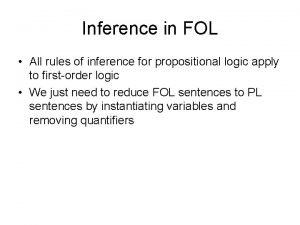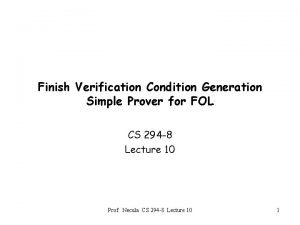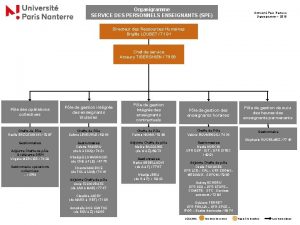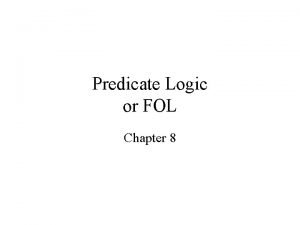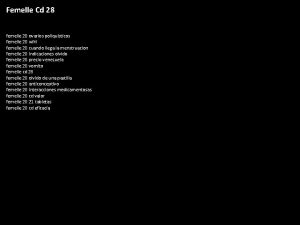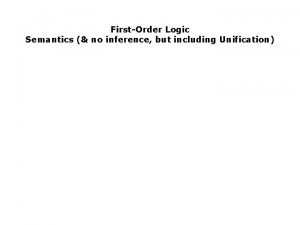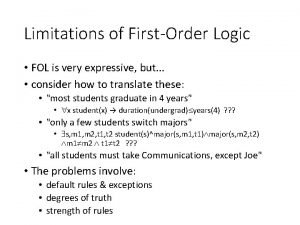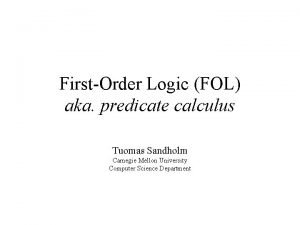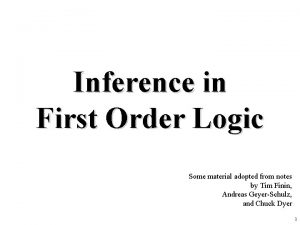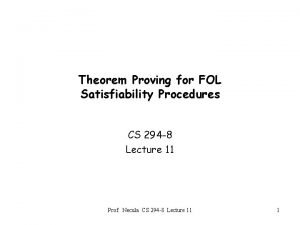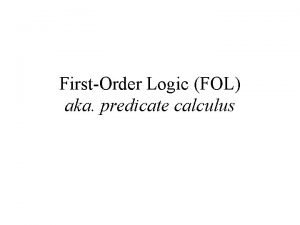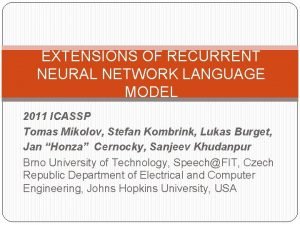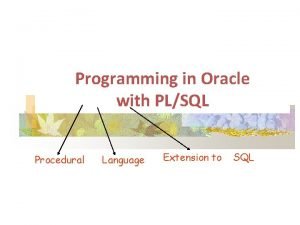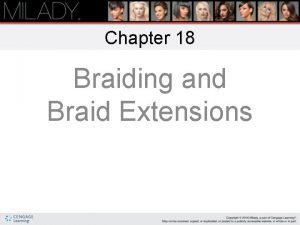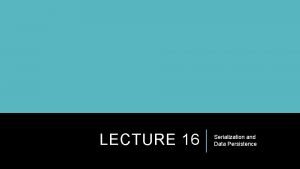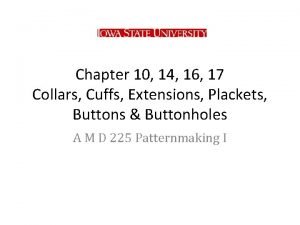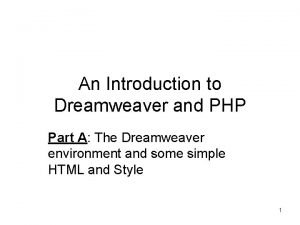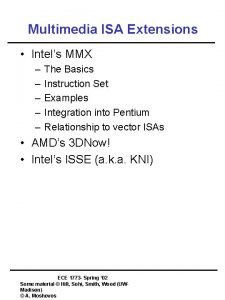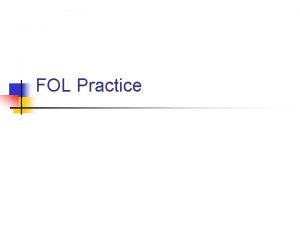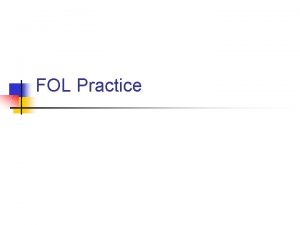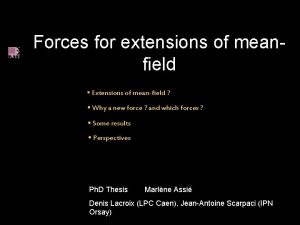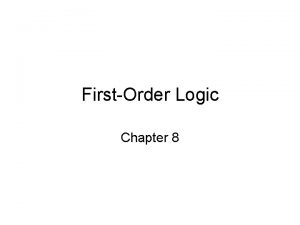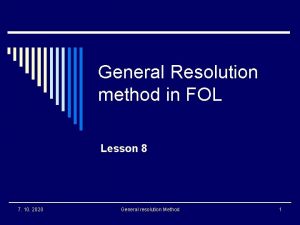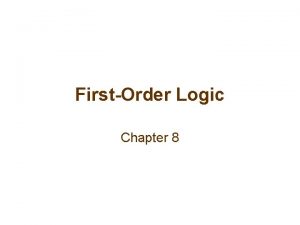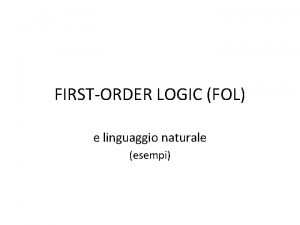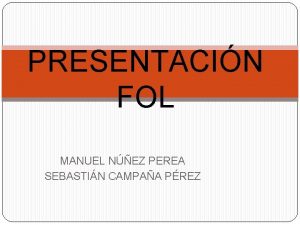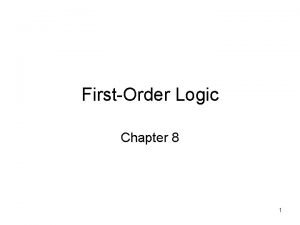Extensions to FOL Extensions to FOL When the









































- Slides: 41

Extensions to FOL

Extensions to FOL • When the form of the statements provides useful information • Rule-based systems • Frame systems • When FOL isn’t enough • Default reasoning and circumscription • Reasoning with uncertainty • Degrees of membership (fuzzy logic) • Reasoning about belief

What Does Really Mean? Has. Children Mother A B definition of B Raining Wet A B A causes B Fever Infection A B A is a symptom of B B causes A Like. Big Get. Hummer A B whenever A occurs, B usually does too So how should we reason with these very different things?

Rule-Based Systems The logic: So, given: a b is equivalent to: fever infection fever infection Conclude: Given: a b fever infection Conclude: But are these two inferences equally useful? fever infection fever

An Example for a Design Task: XCON (1982) From XCON (1982): If: the most current active context is distributing massbus devices, and there is a single-port disk drive that has not been assigned to a massbus, and there are no unassigned dual-port disk drives, and the number of devices that each massbus should support is known, and there is a massbus that has been assigned at least one disk drive that should support additional disk drives, and the type of cable needed to connect the disk drive to the previous device on the massbus is known Then: assign the disk drive to the massbus.

An Example for a Diagnosis Task: Mycin (1975) If: (1) the stain of the ogranism is gram-positive, and (2) the morphology of the organism is coccus, and (3) the growth conformation of the organism is clumps Then: there is suggestive evidence (0. 7) that the identity of the organism is staphylococcus.

Simple Examples Today e. Xpertise 2 Go: http: //www. expertise 2 go. com/ Acquired. Intelligence: http: //www. aiinc. ca/demos/ (whales, graduate school) Decision. Script: http: //www. vanguardsw. com/decisionscript/Examples. htm

Implementation of Rule-Based Systems If (1) the suggested technique category is correlation and regression analysis, and (2) one of the values of the desired correlation/regression result is a measure of the degree to which 2 variables move together Then the suggested analysis approach is to calculate a sample correlation coefficient If a b reply(sampcor) • Prolog: The KB: A query: reply(sampcor) : - a, b ? - reply(X) Use backward chaining to answer the question. • Expert system shells: Typically combine methods

Expert System Shells Some rules are best used in forward chaining mode. For example, data collection and reasoning from symptoms. Other rules (e. g. , how to achieve goals) are best used in backward chaining mode. All these rules may also want to exploit other kinds of knowledge, like default information associated with classes of objects:

Inheritance, Again birds ISA robins Instance-of Tweety canfly T ISA ostriches Instance-of Richy Scooter is a bird. Can Scooter fly? canfly F

Inheritance Objects inherit from their parents: • Scooter inherits from Bird the facts that: • its birthmode is eggs, and • it has two wings Should Scooter inherit from Bird the fact that it can fly?

Default Reasoning • The importance of default reasoning • Default reasoning is nonmonotonic. • Techniques for default reasoning • Inheritance • The closed world assumption • Circumscription • Maintaining consistency in nonmonotonic reasoning systems

Default Reasoning - Examples Inheritance from superclasses: x bird(x) canfly(x) UNLESS ostrich(x) The “normal” case: x bird(x) canfly(x) UNLESS (broken-wing(x) sick(x) in(oil-slick, x)) The closed world assumption: can cats fly? Abduction: infection fever Given fever, can we conclude infection?

Default Reasoning in Nonmonotonic Inference in FOL systems is monotonic: The addition of any new assertion that is consistent with the KB will never cause a formula that was previously true to become false. Default reasoning may be nonmonotonic: Birds can fly. Tweety is a bird. Tweety can fly. But what if we now learn: Tweety is an ostrich. Tweety has a broken wing. or

Implementing Inheritance birds ISA robins Instance-of Tweety canfly T ISA ostriches canfly F Instance-of Richy If we implement inheritance procedurally, we don’t have to write the UNLESS clauses. We assume Tweety isn’t an ostrich.

The Closed World Assumption The CWA: Any ground atomic sentences that are not asserted to be true in the KB can be assumed to be false. We make the closed world assumption for two reasons: • We have to. In any complex domain, there may be a huge number of possible facts and there isn’t time to mention each of them explicitly: • A database of classes mentions the ones that are offered. • An inventory database mentions all the objects on hand. • An airline scheduling system assumes that it will be told if the power is out or the terminal has burned down or is held by terrorists or there is a storm. • It is consistent with felicitous human communication.

Implementing the CWA: Negation as Failure A common way to implement the CWA: Interpret failure to prove p as a proof of p. Example: hasonhand(x) uses(x) mustorder(x) How do we prove hasonhand(x)?

Circumscription x bird(x) canfly(x) UNLESS (broken-wing(x) sick(x) in(oil-slick, x)) Is different from: x bird(x) broken-wing(x) sick(x) in(oil-slick, x) canfly(x) Or: x bird(x) adult(x) withmother(x) One way to implement this is to create the predicate Abnormal: x bird(x) canfly(x) UNLESS Abnormal(x) (broken-wing(x) sick(x) in(oil-slick, x)) Abnormal(x)

Circumscription Then we circumscribe Abnormal, i. e. , we prefer models in which Abnormal is true of the smallest possible number of individuals consistent with the rest of the KB. But what happens if we are told just: bird(Tweety) and then we conclude canfly(Tweety) Then we are told: broken-wing(Tweety) How do we undo the conclusion canfly(Tweety)?

Abbott, Babbitt, and Cabot

Truth Maintenance Systems The basic idea: Associate with each assertion one or more justifications. Believe any assertion with at least one valid justification. Each justification is composed of two parts: • An IN-list • An OUT-list We will define the operation of a TMS that operates as a service to a separate reasoning system. The TMS doesn’t make choices. It is just a bookkeeper.

The Structure of a Justification

Before Alibis

Abbott’s Situation, with Alibi

Babbitt’s Situation

Cabot’s Situation

The Big Picture

New Facts Come In

Deciding How to Resolve the Conflict

Abduction Examples: infection fever measles spots raining wetsidewalks If given: fever, can we conclude infection? spots, can we conclude measles? wetsidewalks, can we conclude raining?

Uncertainty and Fuzziness • Degrees of truth John is tall. John is very tall. • Probability of truth John is in Austin Coin is heads (p =. 6) (p =. 5) • Certainty of belief John is in Austin Coin is heads (c =. 2) (c = 1) a wild guess sure it’s 50/50

When Must We Deal with Uncertainty? • Diagnosis: Observe: spots, fever, headache. What’s wrong with the patient? Observe: clothes are wrinkled and hot. What’s wrong with the dryer? • Interpretation: • Speech understanding • Language understanding • Image understanding • Data interpretation • Planning: If I turn the steering wheel, where will the car go?

Probabilistic Reasoning P(strep) = x (the probability that a random person has strep right now) P(staph) = y (similar) Suppose that we can use the same drug in either case, so we want to know P(strep staph) =

Probabilistic Reasoning P(strep) = x (the probability that a random person has strep right now) P(staph) = y (similar) Suppose that we can use the same drug in either case, so we want to know P(strep staph) = P(strep) + P(staph) - P(strep staph)

Probabilistic Reasoning Suppose There are Three Factors P(a b c) = P(a) + P(b) + P(c) - P(a b) - P(a c) - P(b c) +P(a b c) = P(a b c) - P(a) - P(b) - P(c) + P(a b) + P(a c) + P(b c)

Conditional Probability P(measles spots) = P(measles | spots) P(spots) definition P(measles spots) = P(spots | measles) P(measles | spots) = P(measles spots) P(measles | spots) = P(spots | measles) P(measles) Bayes Rule P(spots) definition

Examples from Diagnosis and Interpretation P(measles | spots) = P(spots | measles) P(measles) P(spots) P(word x | sound y) = P(sound y | word x) P(word x) P(sound y) Word = Argmax(P(sound y | word x) P(word x)) x

Naïve Bayes Classifier What if Multiple Observations Are Available? P(measles | spots fever) = P(spots fever | measles) P(measles) P(spots fever) Assume spots and fever are independent: = P(spots fever | measles) P(measles) P(spots fever) = P(spots|measles) P(fever | measles) P(measles) P(spots) P(fever) Disease = Argmax(P(spots|x) P(fever |x) P(x) ) x

Not Quite So Naïve Bayes Classifier Comparing chicken pox (pox) to measles: P(measles | spots fever) = P(spots fever | measles) P(measles) P(spots fever) Assume spots and fever are independent given measles or pox and measles and pox are independent: = P(spots|measles) P(fever | measles) P(measles) P(spots fever) = P(spots|measles) P(fever | measles) P(measles) P(spots|measles)*P(fever|measles)*P(measles) + P(spots|pox)* P(fever|pox)*P(pox) Disease = Argmax(P(spots|x) P(fever |x) P(x) ) x

Learning Naïve Bayes Classification An important aspect of naïve Bayes classification is that a classifier can be learned. Where do numbers like p(spots | measles) come from? Answer: patient diagnosis fever cough spots sore throat sneezes achy 1 Measles Yes Yes No No Yes 2 Measles Yes No No Yes 3 Measles Yes No No No 4 Chickenpox Yes No No 5 Chickenpox Yes No No No

Various ad hoc Approaches Unfortunately, it often happens that we don’t have all the joint probabilities required to compute true probabilities for our conclusions. So a variety of approximate methods are used. http: //www. expertise 2 go. com/webesie/tutorials/Inference/Conf idence 1. htm
 Fol eol
Fol eol Inference in fol
Inference in fol Fol
Fol Organigramme fol 74
Organigramme fol 74 Fol is a
Fol is a Conjuctive normal form concentrates on eliminating
Conjuctive normal form concentrates on eliminating Femelle 20 cd baja de peso
Femelle 20 cd baja de peso Resolution in fol
Resolution in fol Fol unification
Fol unification Fol in ai
Fol in ai Fol
Fol Resolution in fol
Resolution in fol Fol
Fol Resolution in fol
Resolution in fol Modus ponens example
Modus ponens example Only one student failed in mathematics fol
Only one student failed in mathematics fol Git strategy
Git strategy Extensions of turing machine
Extensions of turing machine Mapping extensions
Mapping extensions Extensions of recurrent neural network language model
Extensions of recurrent neural network language model Introducing and naming new products and brand extensions
Introducing and naming new products and brand extensions Visual studio authoring extensions
Visual studio authoring extensions Data mining extensions
Data mining extensions Oracle procedural language extensions to sql
Oracle procedural language extensions to sql Brand extensions
Brand extensions Sw guard extensions
Sw guard extensions Tall pad extensions are used
Tall pad extensions are used Chapter 18 braiding and braid extensions
Chapter 18 braiding and braid extensions Azure data studio vs ssms
Azure data studio vs ssms Brand extensions
Brand extensions Pse restoration
Pse restoration Can't pickle psycopg2.extensions.connection objects
Can't pickle psycopg2.extensions.connection objects Extensions of demand and supply analysis
Extensions of demand and supply analysis Non convertible collar
Non convertible collar In metaphoric extension the novel stimulus shares
In metaphoric extension the novel stimulus shares University of kent extensions
University of kent extensions Dreamweaver php tutorials
Dreamweaver php tutorials Multimedia mail extension
Multimedia mail extension Reactive programming for net developers
Reactive programming for net developers Intel isa extensions
Intel isa extensions Simd extensions
Simd extensions Introducing and naming new products and brand extensions
Introducing and naming new products and brand extensions

